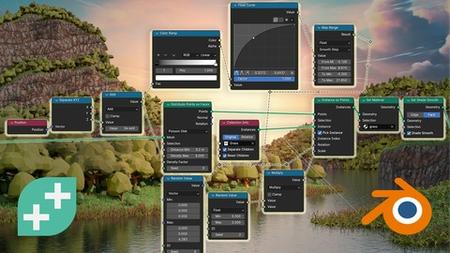
English | MP4 | AVC 1280×720 | AAC 44KHz 2ch | 44 lectures (6h 33m) | 4.70 GB
Learn to create complex 3D models procedurally with Geometry Nodes
Ready to learn a powerful new tool for non-destructive, procedural modelling?
Geometry Nodes allows to you create complex 3D models procedurally, so you can create models that may be difficult or time-consuming using traditional modelling.
The non-destructive aspect of Geometry Nodes means changes can be made to your models and node trees without having to start from scratch. Dependencies can be built into node trees that will automatically take into account other changes in your scene.
Geometry Nodes is flexible and efficient, allowing you to save all or portions of individual node trees to re-use later and save precious time.
By creating node trees by visually connecting different nodes, Blender users can gain a greater understanding of the processes of procedural modelling.
- Learn the core concepts used in Geometry Nodes; data types, boolean math for selection, fields and attributes etc.
- Discover how to manipulate geometry, meshes and curves directly in the Geometry Node editor while learning about the most vital nodes and workflows.
- Create a Modifer that can be used to populate any mesh with a low-poly forest, complete with trees, rocks, bushes and grass.
- Use curves to create your own objects that can be used in your scenes, from simple blades of grass and leaves, fencing that follows terrain automatically, and finally a stylised tree generator.
So if you want to learn a powerful new tool for non-destructive, procedural modelling and create your own modifiers, operators and mesh editing tools this is the course for you!
You’ll need a basic knowledge of Blender and the ability to run Blender 4.0 (or a later version of Blender).
What you’ll learn
- Learn the core concepts used in Geometry Nodes; data types, boolean math for selection, fields and attributes etc.
- Discover how to manipulate geometry, meshes and curves directly in the Geometry Node editor while learning about the most vital nodes and workflows.
- Create a Modifer that can be used to populate any mesh with a low-poly forest, complete with trees, rocks, bushes and grass.
- Data types used in Blender, how to identify and use them, and how fields and attributes are used in Geometry Nodes
- Manipulate geometry, primitive meshes and curves directly in Geometry Nodes in a non-destructive workflow.
- Basic concepts and more advanced workflows for populating scenes with instances of simple or more complex geometr
- Use curves to create your own objects that can be used in your scenes.
- Fundamentals of Geometry nodes in Blender.
Table of Contents
Introduction & Setup
1 Course Introduction
2 Downloading & Installing Blender 4
3 Setting Up Blender for Geometry Nodes
Geometry Node Basics
4 Section Introduction – Geometry Node Basics
5 The Spreadsheet
6 Data Types
7 Socket Types – Floats & Integers
8 Socket Types – Boolean & Vector
9 Fields & Attributes
Instancing Geometry
10 Section Introduction – Instancing Geometry
11 Adding & Manipulating Primitives
12 Adding Materials & Smooth Shading
13 Distribute Points On Faces
14 Instance On Points
15 Instance On Points – Challenge Solution
16 Instancing Collections
17 Controlling Density
18 Manipulating Instances Using Distance Fields
19 Combining Distance Fields
20 Adding Low Poly Trees & Boulders
21 Adding Low Poly Pebbles & Grass
22 Challenge Solution – Tidying Up The Node Tree
23 Base Mesh Displacement & Shading
24 Replacing The Base Mesh
25 Setting Up Switches
26 Setting Up Simple Lighting
27 Using Vertex Groups for Density
28 Setting Random Colors Per Instance
29 Final Adjustments to The Node Tree
30 Setting Up The Render
31 Final Render
Using Curves
32 Bezier Splines
33 Using Bezier Splines in Geometry Nodes
34 Curve Primitives in Geometry Nodes
35 Fill & Fillet Curve Nodes
36 More Curve Operations
37 Resample Curve Node
38 Reshaping Curves
39 Creating a Blade of Grass
40 Creating a Grass Shader
41 Creating Random Variations
42 Creating Grass Clumps
More To Come
43 More To Come
Resolve the captcha to access the links!